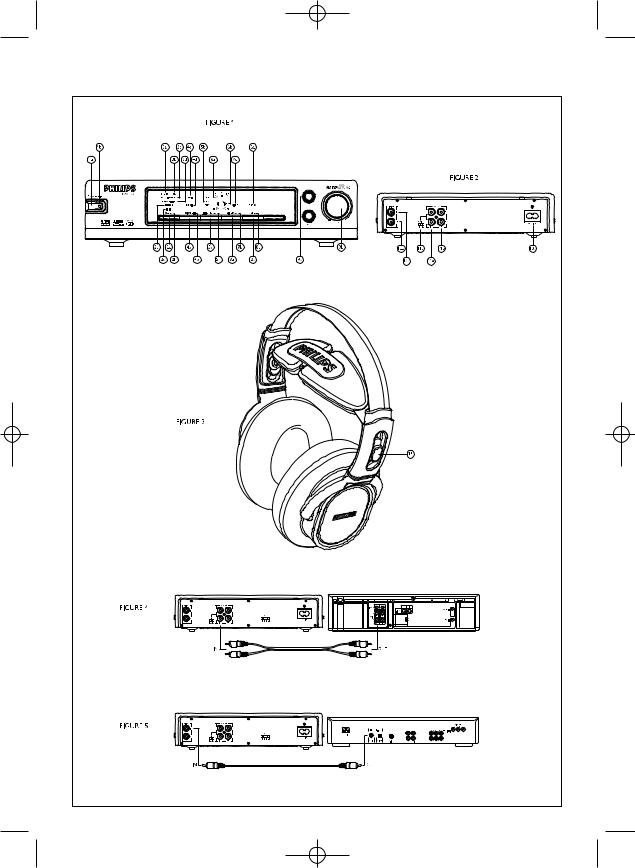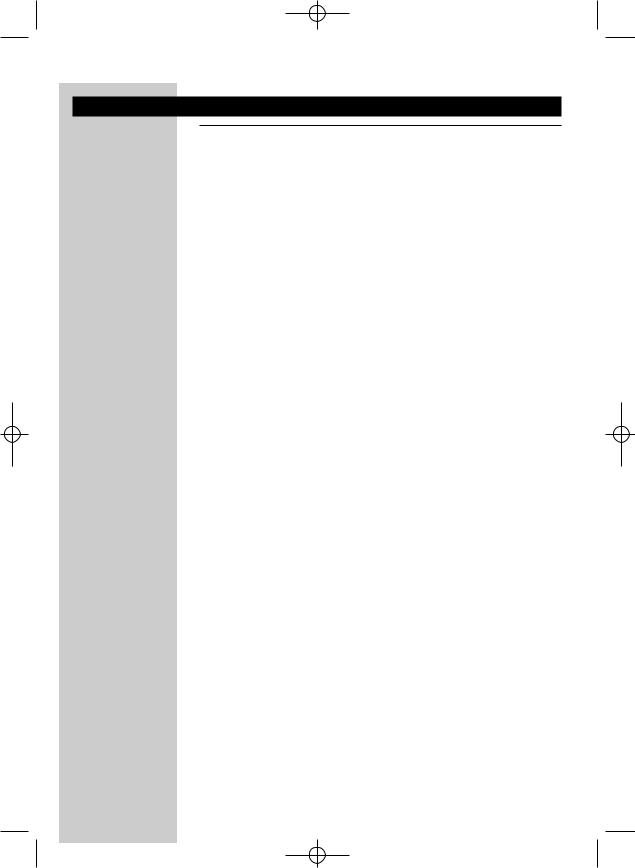Philips HP1500 User Manual

0912HP_EU 09-12-2003 12:12 Pagina 1
HP1500
Instructions for use
English 4
Mode d'emploi
Français 30
Bedienungsanleitung
Deutsch 56
Gebruiksaanwijzing
Nederlands 82
Instrucciones de manejo
Español 108
Manual de utilização
Português 134
Instruzioni per l'uso
Italiano 160
Bruksanvisning
Svenska 186

0912HP_EU |
09-12-2003 |
12:12 |
Pagina 2 |
3 |
|
|
|

0912HP_EU 09-12-2003 12:12 Pagina 3
2
Helpline (www.p4c.philips.com)
België/Belgien/Belgique |
Nederland |
32-2-525.81.11 |
0900-8406 |
Danmark |
Norge |
45 33 29 33 33 |
47-22-748 000 |
Deutschland |
Österreich |
49-40-28990 |
43-1-601 01 |
España |
Portugal |
34-91-4042200 |
+351-21-416 33 33 |
France |
Schweiz/ Suisse/ Svizzera |
33 1 47 28 10 00 |
41-1-48 82 211 |
|
Suomi |
30-1-4894911 |
358-9-615 800 |
Ireland |
Sverige |
353-1-764 0000 |
468 598 520 00 |
Italia |
UK (United Kingdom) |
39.039.203.1 |
44-208-689 2166 |
‘Dolby’,‘Pro Logic’ and the double-D symbol are trademarks of Dolby Laboratories.
‘DTS’ and ‘DTS Virtual’ are trademarks of Digital Theater Systems, Inc.

0912HP_EU 09-12-2003 12:12 Pagina 4
4 ENGLISH
Index
4Introduction
5System configuration
6Dolby Headphone
7Advanced technologies used in HP 1500
10Digital audio formats
10Important information
11Benefits of latest sound processing technology
11Kit contents
12Functional overview
15 |
Installation |
15 |
Audio connections |
26Basic operation
27Problem solving
28Maintenance
28Technical specifications
29European Regulations
Introduction
SBC HP1500
Congratulations! You have just bought a most sophisticated digital headphone system.
This system uses state of the art digital technology, offering you the freedom of enjoying your favourite music or movies in the purest digital quality.
Even silent passages in classical music and plain silence in between two music tracks are reproduced as pure silence.

0912HP_EU 09-12-2003 12:12 Pagina 5
ENGLISH 5
This system has been designed to faithfully reproduce the kind of multi-channel surround sound experience that you normally can enjoy with a conventional multi-channel speaker set-up.The latest digital signal processing technology is being used to ensure that you can indulge yourself in an overwhelming private home entertainment experience.
And all this at the volume level that you personally prefer without running the risk of disturbing the neighbours or the family!
To ensure you get the best performance from your digital headphone system please read this manual carefully.
System configuration
The HP 1500 system consists of a digital base station and a pure
Hifi headphone.The base station contains a digital signal processor offering you a real 5.1-channel surround sound experience through the personal comfort of your headphone.
The base station can decode Dolby Pro Logic II signals as well as Dolby Digital and DTS signals.The Dolby Headphone technology will
ensure that these signals are converted to audio signals that can be handled by the headphone whilst still maintaining the directional information as in the original signals.
The base station has an analogue stereo input as well as a digital electrical coaxial S/PDIF input.The digital input allows you to enjoy your favourite DVD movies in full surround sound through Dolby Pro Logic II,
Dolby Digital or DTS. And the analogue input brings your collection of VCR tapes back to life in full Dolby Pro Logic II surround sound.
The pure Hifi headphone that comes with the HP1500 system will provide you with pure audio quality that is second to none.
|
Power |
User |
Control |
|
|
Block Diagram |
||
|
Supply |
Interface |
|
|
|
|
|
|
|
|
|
|
|
|
|
||
|
Audio Processing |
|
|
|
|
|
|
|
|
|
HP1500 Basestation |
|
|
|
|
|
|
DIG |
DAI |
|
DD |
|
|
|
|
|
|
|
IN |
|
|
|
|
HP |
|
|
|
DTS |
DPLII |
DH |
DAC |
DBE |
||
|
|
SEL |
AMP |
|||||
|
|
LPCM |
|
|
|
|
||
ANA |
ADC |
|
|
|
|
|
|
|
|
|
|
|
|
|
|
||
|
Basestation Audio Processing |
|
|
|
|
|
||

0912HP_EU 09-12-2003 12:12 Pagina 6
6 ENGLISH
Dolby Headphone
A brief introduction
Dolby Digital and DTS provide discrete left and right surround channels, for more precise localization of sound and a more convincing, realistic ambience. Discrete means that each channel contains its own particular audio information and plays a unique role in creating a realistic surround sound experience.
Up until now all this was reserved to speaker set-ups, but thanks to
Dolby Headphone, the ultimate experience in home theatre surround with five (left, right, centre, rear-left and rear-right) discrete channels of digital sound quality is now also available to headphones.
Dolby Headphone is a revolutionary signal processing system that works not only with multi channel audio but also with conventional stereo signals. In case of multi channel audio signals, Dolby Headphone technology will process these signals in such a way that you will experience the sound through your headphone as if it were coming from an actual five speaker home entertainment set-up. And even when listening to conventional stereo signals, Dolby Headphone will give you a much more natural and less fatiguing listening experience, equivalent to a good two-speaker playback system in a room with good acoustics.
Dolby Headphone technology can model the sound of a playback system in up to three different listening environments, based on acoustic measurements of real rooms:
•DH1 is a small, well-damped room appropriate for both movies and music-only recordings.
•DH2 is a more acoustically live room particularly suited to music listening, but also great for movies.
•DH3 is a larger room, more like a concert hall or movie theatre.
You can easily switch between these room modes and select whichever one suits the particular program material and your own preferences.

0912HP_EU 09-12-2003 12:12 Pagina 7
ENGLISH 7
Advanced technologies used in HP 1500
The HP1500 makes use of several advanced technologies.
Principle of determining the direction of sound
People can determine the localization of sounds through the perception of differences in intensity – so called Interaural Intensity Difference (IID) – and through time differences – so called Interaural Time Difference (ITD).
IID is about the fact of sounds being louder as they are closer to the ear and being louder in case they have a non-obstructed path to the ear.
ITD is about the fact that in most cases sounds will arrive earlier in time at one ear than at the other.
In fact it is the environment itself that greatly impacts the sound before it reaches our ears. Reflections and absorption all will influence the sense of distance and direction we associate with a sound.
Combining IID and ITD will allow the brain to determine the direction of sounds only in a rough way. It is in through the combination of IID and ITD and the way sounds are filtered because of the structure of the pinna
– the outer ear – that allows to brain to accurately localise sounds.
•Depending on how a sound wave hits the pinna, it will be emphasized or suppressed.
•Depending on how a sound wave hits the pinna, reflections within the pinna are created, altering the phase relationship within the spectrum of the sound wave.
•And also: higher frequencies are more affected by the pinna than lower frequencies.That’s why our brain can easily locate higher frequencies, rather than lower frequencies.

0912HP_EU 09-12-2003 12:12 Pagina 8
8 ENGLISH
If we wish to reproduce all those effects through an audio system, than we need to take IID, ITD, pinna effects, room impulse response, etc. into account.That is where Head-Related Transfer Functions (HRTF) come into play.
An HRTF is a mathematical equation that describes how a sound is effected when travelling from its source to our ears.
There are several ways to synthesise an HRTF.The most common way to measure an HRTF makes use of placing tiny microphones in a listener’s ears.
Every person has its unique HRTF. However, we can identify crucial parts in an HRTF that are responsible for localization of sound as if this sound would be radiated by a typical home cinema speaker set-up.
When these parts are synthesized in an optimal way, a typical 5 speaker setup listening experience is created.
HRTFs are implemented in real-time Digital Signal Processors (DSP) and will then be applied to audio signals in order to reproduce "spatial" cues, i.e. create a sense of directionality.
It is through these techniques that Philips is able to bring you a home cinema experience through a headphone that is as real as when you would be listening to an actual 5.1 speaker set-up.

0912HP_EU 09-12-2003 12:12 Pagina 9
ENGLISH 9
Automatic Audio Signal Routing
The Automatic Audio Signal Routing (AASR) feature of the HP 1500 basestation allows for audio sources to be connected to its audio inputs and at the same time it can pass those same audio signals on to – for example – your Home Cinema receiver.This allows for permanent audio connections to be made without the need for swapping cables. Whether you want to listen to your headphone or your existing speaker set-up, it no longer involves tiresome swapping of cables: the choice is yours at the flick of a switch.
Intelligent user interface
After a digital analysis of the audio input signal the display will indicate which sound processing features can be activated. No more frustrating pressing of all buttons. Just read the display and select out of the active sound menus.
Headphone construction
The headphone’s semi-open construction will benefit the transparency of the sound.This will make you experience your favourite tracks under even more realistic conditions.
Neodymium magnets
Neodymium is the strongest magnet material available, which optimises the behaviour of the speaker coil for increased sound pressure levels and a more powerful bass response. All this at the lowest possible levels of distortion.
